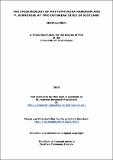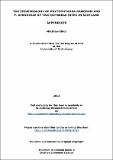Files in this item
The epidemiology of Phytophthora ramorum and P. kernoviae at two outbreak sites in Scotland
Item metadata
| dc.contributor.advisor | Meagher, Thomas | |
| dc.contributor.advisor | Harris, Catriona | |
| dc.contributor.author | Elliot, Matthew | |
| dc.coverage.spatial | 142 | en_US |
| dc.date.accessioned | 2014-03-11T16:31:15Z | |
| dc.date.available | 2014-03-11T16:31:15Z | |
| dc.date.issued | 2013-09-18 | |
| dc.identifier | uk.bl.ethos.595608 | |
| dc.identifier.uri | https://hdl.handle.net/10023/4515 | |
| dc.description.abstract | This PhD examined the epidemiology of two potentially devastating plant pathogens, Phytophthora ramorum and P. kernoviae, at Benmore Botanic Garden in Argyll & Bute and Brodick Castle Garden in Arran. Spore traps, river baiting, bait plants and soil sampling were used to both confirm the presence of, and measure the amount of inoculum in the environment in order to quantify the relationship between inoculum levels and disease development. P. ramorum was detected in spore traps at high levels under a sporulating host throughout the year at Benmore. Also, findings at sites where infected hosts had been removed before the study led to the conclusion that the low level spore traps detect inoculum from soil splash. Rhododendron and Vaccinium bait plants were also infected with P. ramorum via soil splash at sites within Benmore where there was no sporulating host present. P. kernoviae was detected in spore traps at Brodick throughout the year but only where there was a sporulating host overhead. P. kernoviae infected bait plants only where an infected host is overhead. Water baiting confirmed the presence of P. ramorum in two streams at Benmore but P. kernoviae was not detected using this method despite the large-scale P. kernoviae infection at Brodick. Inoculum continued to be detected in soil in areas of both gardens where infected hosts had been removed two years previously, confirming that both of these pathogens can survive in soil for a considerable period. A number of statistical models were produced to describe conditions required for P. ramorum sporulation and infection. Sporulation occurred during warmer and wetter conditions and infection of bait plants occurred in wet conditions and where an infected host is in close proximity. A statistical model was also used to produce a P. ramorum risk map, uniquely at the garden scale, to enable garden managers at Benmore to visualise the areas most at risk within their garden. The findings of this study have clear management implications for the control of disease establishment and spread within the garden setting. | en_US |
| dc.language.iso | en | en_US |
| dc.publisher | University of St Andrews | |
| dc.rights | Creative Commons Attribution-NonCommercial-NoDerivs 3.0 Unported | |
| dc.rights.uri | http://creativecommons.org/licenses/by-nc-nd/3.0/ | |
| dc.subject | Phytophthora | en_US |
| dc.subject | Ramorum | en_US |
| dc.subject | Kernoviae | en_US |
| dc.subject | Epidemiology | en_US |
| dc.subject | Plant pathogen | en_US |
| dc.subject | Oomycete | en_US |
| dc.subject.lcc | SB741.P58E6 | |
| dc.subject.lcc | SB741.P58E6 | |
| dc.subject.lcsh | Phytophthora diseases--Scotland | en |
| dc.subject.lcsh | Phytophthora ramorum--Scotland | en |
| dc.subject.lcsh | Phytopathogenic microorganisms--Scotland | en |
| dc.subject.lcsh | Oomycetes | en |
| dc.title | The epidemiology of Phytophthora ramorum and P. kernoviae at two outbreak sites in Scotland | en_US |
| dc.type | Thesis | en_US |
| dc.type.qualificationlevel | Doctoral | en_US |
| dc.type.qualificationname | PhD Doctor of Philosophy | en_US |
| dc.publisher.institution | The University of St Andrews | en_US |
This item appears in the following Collection(s)
Except where otherwise noted within the work, this item's licence for re-use is described as Creative Commons Attribution-NonCommercial-NoDerivs 3.0 Unported
Items in the St Andrews Research Repository are protected by copyright, with all rights reserved, unless otherwise indicated.



